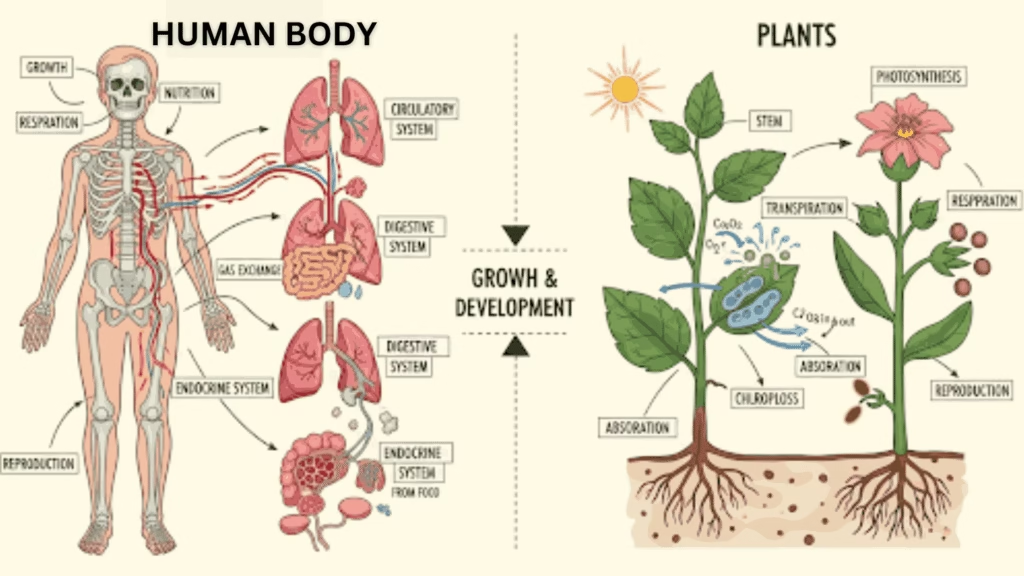
Master Life Processes Class 10 with crystal-clear explanations! Discover how living organisms breathe, eat, transport nutrients, and excrete waste through engaging visuals, quizzes, and fun facts.
Perfect for CBSE students – turn complex biology into easy, bite-sized learning.
Table of Contents
Introduction: Life Processes Class 10
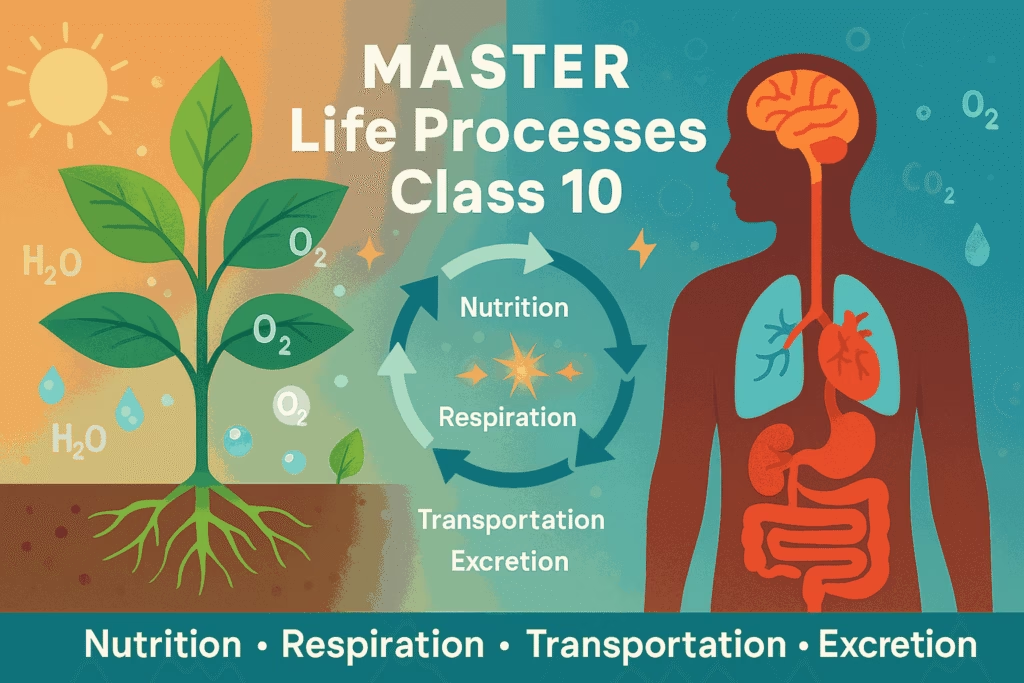
Living vs Non-Living Things
How to tell what’s alive and what’s not – Fun science lesson!
Test Your Knowledge!
1. Which of these is NOT a sure sign that something is alive?
2. Why do living things need molecular movement?
3. Why are viruses not considered alive by some scientists?
Key Takeaway
- Living things maintain themselves through constant molecular movement, even when we can’t see any changes from the outside.
- Remember: Visible movement alone doesn’t define life – it’s what’s happening inside that counts!
WHAT ARE LIFE PROCESSES?
Life Processes
Essential functions that keep living organisms alive and functioning!
What are Life Processes?
Life processes are the essential maintenance functions that keep living organisms alive and functioning. These processes continue even when organisms are resting or sleeping.
For example, when you’re sitting in class or sleeping, your body is still performing vital functions like breathing, circulating blood, and digesting food.
These maintenance processes require energy, which comes from outside the body through food. The process of transferring energy from food into the body is called nutrition.
Nutrition
Nutrition is the process by which organisms obtain and utilize food for growth, repair, and energy. Since life on Earth depends on carbon-based molecules, most food sources are also carbon-based.
Did You Know?
Different organisms use different nutritional processes depending on the complexity of their carbon sources.
Food sources need to be broken down into simpler molecules that can be used for:
- Energy production
- Cellular maintenance
- Growth and repair
Respiration
Respiration is the process of acquiring oxygen from the environment and using it to break down food sources for cellular energy needs.
Organisms use oxidising-reducing reactions to break down molecules. Oxygen is used in these reactions to release energy stored in food molecules.
In single-celled organisms, respiration occurs through simple diffusion across the cell membrane. But in multicellular organisms, specialized respiratory systems are needed.
Transportation
In multicellular organisms, simple diffusion is insufficient to meet the needs of all cells. This creates the need for a transportation system.
Circulatory System
Carries oxygen and nutrients to all cells and removes waste products.
Respiratory System
Transports oxygen from the environment to the blood and removes carbon dioxide.
Specialized tissues and organs work together to ensure all body parts receive necessary materials.
Excretion
Excretion is the process of removing harmful waste by-products created during energy-generating chemical reactions.
Waste products can be toxic to cells if they accumulate. Excretion maintains the internal balance of the body and prevents damage to cells.
In complex organisms, specialized excretory tissues work with the transportation system to remove waste from cells.
Test Your Knowledge!
1. Why is diffusion insufficient to meet the oxygen requirements of multicellular organisms like humans?
2. What criteria do we use to decide whether something is alive?
3. What are outside raw materials used for by an organism?
4. What processes would you consider essential for maintaining life?
Key Takeaways
- Life processes are the fundamental activities that maintain living organisms, including nutrition, respiration, transportation, and excretion.
- These processes work together to convert external resources into usable energy, distribute materials throughout the body, and remove waste products.
NUTRITION
Nutrition: Your Body’s Fuel!
Understanding how food powers your amazing body!
Test Your Genius!
1. Plants make food using:
2. Enzymes are:
3. A human is a:
4. Bio-catalysts help in:
Summary
- Nutrition: Food -> Energy + Materials
- Autotrophs: Self-feeders (plants!)
- Heterotrophs: Food explorers (animals/humans!)
- Enzymes: Bio-catalysts that cut food
- Challenge: Draw a food chain with: Sun -> Grass -> Goat -> Human -> Enzymes (cutting food in the tummy)!
Autotrophic Nutrition
Autotrophic Nutrition: Plant Power!
Discover how plants make their own food!
Autotrophic Nutrition: Plant Power!
Plants are nature’s chefs! They make their *own* food through **autotrophic nutrition** using sunlight, air, and water.
| Technical Word | Simple Meaning |
|---|---|
| Autotrophic Nutrition | Plants making food from sunlight/air/water |
| Photosynthesis | Food-making process using light |
| Chlorophyll | Green sunlight-trapping pigment |
| Chloroplasts | Tiny cell factories holding chlorophyll |
| Stomata | Leaf pores that “breathe” CO₂ |
| Guard Cells | Gatekeepers that open/close stomata |
| Carbohydrates | Sugary food plants make |
| Starch | Stored plant food (snack drawer!) |
Ans. **Chloroplasts**
Ans. **Photosynthesis**
Ans. **Guard Cells**
Photosynthesis: The Recipe!
Plants cook food in 3 steps:
- Sun Grab! → Chlorophyll absorbs light.
- Water Split! → Light breaks water into Hydrogen + Oxygen.
- Food Cook! → Hydrogen + CO₂ = **Carbohydrates**.
Ans. To breathe in CO₂ from the air!
Fun Fact: Plants release oxygen we breathe – they’re Earth’s lungs!
Chloroplasts & Stomata Teamwork
- Chloroplasts → Food factories
- Stomata → CO₂ in / Oxygen out
- Guard Cells → Close stomata on hot days to save water
Ans. Stomata **close** to prevent water loss!
Fun Fact: Cacti open stomata only at night!
Plant Supermarket: Soil!
Roots grab from soil:
- Water → For photosynthesis
- **Nitrogen** → To make proteins (like eggs for you!)
- Phosphorus/Iron → Plant “vitamins”
Ans. To give plants extra **nitrogen** for growth!
Quiz Time!
1. Photosynthesis needs:
2. Stored plant food is called:
3. Guard cells help to:
4. Plants get nitrogen from:
Summary
- Photosynthesis Recipe: Sunlight + CO₂ + Water -> Glucose + Oxygen
- Chloroplasts = Food factories
- Stomata = Breathing pores (controlled by **guard cells**)
- Extra food -> **Starch** storage
- Soil provides **nitrogen** for proteins
Heterotrophic Nutrition
Heterotrophic Nutrition: Food Adventurers!
Explore how organisms get food from others!
Heterotrophic Nutrition: Food Adventurers!
Organisms that **can’t cook their own food** are heterotrophs! They explore, hunt, or steal meals. Examples: You, lions, mushrooms, and even pesky parasites!
| Technical Word | Simple Meaning |
|---|---|
| Heterotrophic Nutrition | Getting food from other living/non-living sources |
| External Digestion | Breaking down food *outside* the body (like fungi) |
| Internal Digestion | Breaking down food *inside* the body (like animals) |
| Parasitic Nutrition | Stealing nutrients from a living host without killing it |
Ans. **Heterotrophs**
Ans. **External Digestion** (digest food outside their body)
Ans. **Parasitic Nutrition**
External Digestion: The Outside Eaters!
Fungi (mushrooms, yeast) are nature’s recyclers! They spit **digestive juices** on dead plants/food -> turn it into soup -> absorb nutrients!
- Example: Bread mould on old bread.
Fun Fact: The world’s biggest fungus is 4 km wide – as big as 1,600 elephants!
Ans. They have no mouth! They digest externally.
Internal Digestion: The Body Processors!
Animals (including you!) use this method:
- Swallow food -> enters body.
- Break it down internally with enzymes/teeth.
- Absorb nutrients in the gut.
– Cow vs. Lion:
- Cow: Eats grass (stationary) -> flat teeth for grinding.
- Lion: Hunts deer (mobile) -> sharp teeth for tearing meat!
Ans. Special stomach chambers and bacteria!
Parasitic Nutrition: Sneaky Thieves!
Parasites live **on or inside** a host, stealing nutrients:
- Cuscuta (Amar-bel): Wraps around plants -> sucks their sap.
- Tapeworms: Live in human intestines -> eat your food!
Warning: Parasites weaken hosts but rarely kill them instantly!
Ans. Ticks, lice, leeches, tapeworms (any two).
Adaptation is Key!
Every heterotroph’s body is designed for its food:
| Food Type | Body Adaptation | Example |
|---|---|---|
| Grass (Stationary) | Flat grinding teeth | Cow |
| Deer (Mobile) | Sharp teeth + claws | Lion |
| Blood | Sucking tubes/sticky body | Mosquito |
Fun Fact: Leeches have 3 jaws with 100 teeth each! They numb skin so you don’t feel their bite.
Quiz Time!
1. Bread mould digests food:
2. Cuscuta (Amar-bel) is a:
3. Parasites:
4. Lions have sharp teeth to eat:
Summary
- Heterotrophs = Food explorers (animals, fungi, parasites).
- 3 Nutrition Strategies:
- – External Digestion (fungi) -> Food broken outside.
- – Internal Digestion (animals) -> Food broken inside.
- – Parasitic Nutrition (cuscuta, tapeworms) -> Steal from hosts.
- Body adaptations match food type (teeth, claws, etc.).
- Challenge: Find three heterotrophs near you:
- 1. An animal (dog/cow) -> Internal Digestion
- 2. A mushroom -> External Digestion
- 3. A mosquito -> Parasite
- Sketch them with their food sources!
How do Organisms obtain their Nutrition?
How Do Organisms Get Their Food?
Exploring diverse feeding strategies in the living world!
How Do Organisms Get Their Food?
Organisms eat in *different ways* depending on their body design! Simple organisms (like tiny single-celled ones) eat with their *whole body*, while complex ones (like humans) have special organs (stomach, intestines).
| Technical Word | Simple Meaning |
|---|---|
| Food Vacuole | Food bubble inside a cell (like a mini stomach!) |
| Cytoplasm | Jelly-like fluid inside cells where digestion happens |
| Cilia | Hair-like wavy arms that move food |
| Pseudopodia | “False feet” – stretchy arms to grab food |
Ans. **Pseudopodia**
Ans. **Food Vacuole**
Ans. **Cilia**
Amoeba: The Blob Hunter!
Amoeba is a tiny water creature (like a squishy water balloon!). How it eats:
- Grabs food with **pseudopodia** (stretchy arms) -> traps it in a **food vacuole**.
- Digests food inside the vacuole (enzymes break it down).
- Absorbs nutrients into the **cytoplasm** (cell jelly).
- Spits out waste by pushing it out of its body!
Fun Fact: Amoeba can eat bacteria 10x smaller than it – like you eating a rice grain!
Ans. It moves waste to the cell surface and pushes it out!
Paramoecium: The Ciliated Foodie!
Paramoecium (slipper-shaped cell) is fancier than Amoeba! It has:
- Cilia (tiny hairs) covering its body -> sweeps food into a **mouth pore**.
- Food vacuole forms -> digestion happens -> nutrients go to **cytoplasm**.
- Waste exits through a special spot (**anal pore**).
Why Cilia? They push food like a conveyor belt!
Ans. Amoeba uses **pseudopodia** anywhere on its body. Paramoecium uses **cilia** to move food to a **fixed mouth spot**.
Simple vs. Complex Bodies
Every heterotroph’s body is designed for its food:
| Organism | Food Intake Method | Special Part |
|---|---|---|
| Amoeba | Whole surface (pseudopodia) | Food vacuole |
| Paramoecium | Fixed mouth spot (via cilia) | Cilia + Mouth pore |
| Humans | Mouth -> Stomach -> Intestines | Digestive system organs |
Fun Fact: If an Amoeba was the size of a watermelon, its pseudopodia could stretch as long as your arm!
Quiz Time!
1. Pseudopodia are used for:
2. Digestion in Amoeba happens inside the:
3. Cilia in Paramoecium act like:
4. Nutrients are absorbed into the:
Summary
- Simple organisms (Amoeba/Paramoecium) digest food in **food vacuoles**.
- Amoeba: Uses **pseudopodia** (stretchy arms) to trap food.
- Paramoecium: Uses **cilia** (hairs) to sweep food to its **mouth pore**.
- Nutrients go into **cytoplasm**; waste is thrown out!
- Challenge: Draw an Amoeba:
- – Show pseudopodia grabbing a food particle.
- – Add a food vacuole with “digestion enzymes” inside!
- (Label it and share in class!)
Nutrition in Human Beings
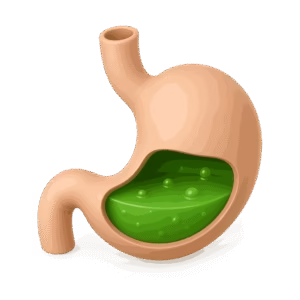
Nutrition in Human Beings: The Food Journey!
Imagine your body is a food-processing factory! The alimentary canal is a 9-meter-long tube from your mouth to your bottom.
Keyword Table
| Technical Word | Simple Meaning |
|---|---|
| Alimentary Canal | Digestive tube (mouth → anus) |
| Saliva | Spit; wets food + starts starch digestion |
| Peristalsis | Muscle waves pushing food down |
| Enzymes | Protein scissors cutting food ✂️ |
| Villi | Finger-like nutrient grabbers in intestines |
| Bile | Green juice breaking fats (from liver) |
| Sphincter | Ring-shaped muscle acting as a gate 🚪 |
1. Mouth: Food’s First Stop!
– Teeth crush food → small pieces.
– Saliva (spit) wets food + contains salivary amylase enzyme → breaks *starch* (roti/bread) into sugar.
– Tongue rolls food into a ball (bolus).
Fun Fact: You produce 1-2 liters of spit daily – enough to fill 2 water bottles! 💧
Ans. Salivary amylase
2. Oesophagus: The Food Slide!
– Food ball (bolus) slides down via peristalsis → muscle squeezes like toothpaste from a tube!
– Works even if you’re upside down! 🙃
⚠️ Key Detail:
– Peristalsis = Automatic muscle contractions – you can’t control them!
Ans. Peristalsis
3. Stomach: The Acid Bath!
– Gastric glands release:
- HCl acid → Kills germs + turns food soupy.
- Pepsin enzyme → Chops *proteins* (eggs/dal).
- Mucus → Protects stomach from acid!
– Pyloric sphincter (gatekeeper!) → releases food slowly into intestines.
🔥 Ouch! Too much acid = “acidity” pain!
Ans. Mucus lining
4. Small Intestine: Digestion HQ!
Food soup (chyme) gets processed:
- Liver sends bile → Breaks *fats* into tiny drops (like soap on oil!) + neutralizes acid.
- Pancreas sends enzymes:
- Trypsin → Chops proteins.
- Lipase → Chops fats.
- Intestinal walls release enzymes → Food becomes:
- Proteins → Amino acids
- Carbs → Glucose
- Fats → Fatty acids + Glycerol
🦠 Absorption:
– Villi (millions of finger-like bumps!) absorb nutrients into blood.
– Blood delivers nutrients to every cell! 💪
📏 Fun Fact: Unfolded villi = Tennis court-sized surface! 🎾
Ans. Grass takes longer to digest than meat!
5. Large Intestine: Poop Factory!
– Absorbs water → Poop solidifies.
– Waste exits via anus (controlled by anal sphincter).
🚽 Fun Fact: Your poop is 75% water + dead bacteria!
Quiz Time!
1. Bile is made by the:
2. Villi help in:
3. Peristalsis occurs in the:
Answers to Textbook Questions
1. Autotrophic vs. Heterotrophic Nutrition:
| Autotrophs (Plants) | Heterotrophs (Animals) |
|---|---|
| Make own food (photosynthesis) | Eat other organisms |
| Need sunlight 🌞 | Need pre-made food 🍔 |
2. Raw Materials for Photosynthesis:
- CO₂ → From air (via stomata)
- Water → From soil (roots)
- Sunlight → Trapped by chlorophyll
3. Stomach Acid’s Role:
- Kills germs in food.
- Turns food liquidy.
- Activates pepsin enzyme.
4. Digestive Enzymes’ Function:
Chop complex food into tiny absorbable pieces:
- Carbs → Glucose
- Proteins → Amino acids
- Fats → Fatty acids + Glycerol
5. Small Intestine Design for Absorption:
- Villi → Increase surface area (like sponge!).
- Rich blood supply → Quick nutrient transport.
- Microvilli → Tiny hairs on villi (extra absorption!).
Summary: Food’s 5-Stop Journey!
- Mouth: Chewing + saliva enzymes.
- Oesophagus: Peristalsis push.
- Stomach: Acid bath + protein chop.
- Small Intestine:
- – Bile (fats) + enzymes (carbs/proteins)
- – Villi absorb nutrients.
- Large Intestine: Make poop → exit!
- 🌟 Challenge: Draw the digestive system! Label:
- – 🦠 Villi in small intestine
- – 🚪 Sphincter between stomach & intestine
- – ✨ Bile from liver
- (Share your art! 🎨)
Respiration
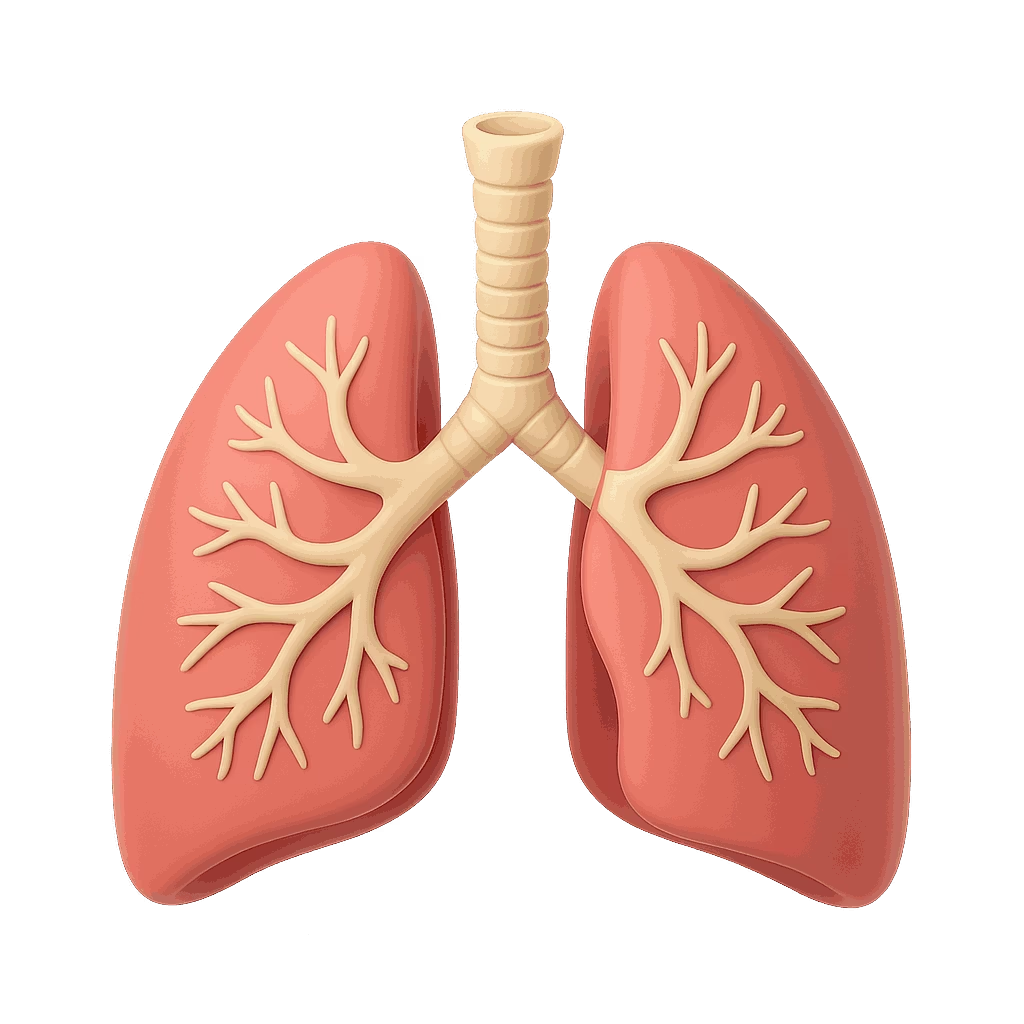
Respiration: The Body’s Energy Factory!
Imagine your cells are tiny power plants ⚡ turning food into fuel! **Respiration** is how they make energy from glucose (sugar). All living things do this, but in *different ways*!
Keyword Table
| Technical Word | Simple Meaning |
|---|---|
| Glucose | Sugar from food (energy source) 🍬 |
| Pyruvate | 3-carbon molecule made from glucose (step 1) |
| Aerobic Respiration | Energy-making *with oxygen* (more energy!) 💨 |
| Anaerobic Respiration | Energy-making *without oxygen* (less energy) 🚫💨 |
| ATP | Energy “coins” for cells 💰 |
| Alveoli | Balloon-like air sacs in lungs 🎈 |
| Hemoglobin | Oxygen taxi in red blood cells 🔴 |
Step 1: Glucose → Pyruvate
– Glucose (6-carbon sugar) breaks into pyruvate (3-carbon).
– Happens in cytoplasm (cell jelly) → needs *no oxygen*.
– *All living things do this!*
⚡ Fun Fact: 1 glucose molecule powers 1 million cells for 1 second!
Ans. Cytoplasm
Aerobic Respiration: Oxygen Power!
If oxygen is present:
- Pyruvate goes to mitochondria (cell powerhouses).
- Breaks into CO₂ + Water + 36 ATP coins 💰.
- Used by humans, animals, and plants during the day! 🌞
🏃 Example: Running → deep breathing for oxygen → max energy!
Ans. Mitochondria
Anaerobic Respiration: No Oxygen? No Problem!
When oxygen is *absent*:
- In Yeast:
Pyruvate → Ethanol + CO₂ (called fermentation).
– Makes bread rise! 🍞
- In Muscles:
Pyruvate → Lactic Acid (during push-ups/sprinting).
– Causes muscle cramps! 💢
⚠️ Ouch! Lactic acid = pain when you overexert!
Ans. Lactic acid
ATP: The Energy Coins!
– Respiration releases energy → stored as ATP (Adenosine Triphosphate).
– Cells “spend” ATP for:
- Thinking 🧠
- Moving 💃
- Growing 📏
🌟 Fun Fact: Your body recycles 40 kg of ATP daily! ♻️
Plant Breathing: Day vs. Night!
Plants “breathe” through stomata (leaf pores):
- Day: 🌞
Photosynthesis > Respiration → Releases O₂ (we breathe this!).
- Night: 🌙
Only respiration → Releases CO₂ (like animals!).
🌼 Fun Fact: A tree releases 260 pounds of oxygen/year – enough for 4 people!
Ans. Photosynthesis uses CO₂ and makes O₂
Animal Breathing Adaptations
| Animal | Breathing Organ | Special Feature |
|---|---|---|
| Fish | Gills 🐟 | Extract oxygen from water |
| Insects | Tracheae (tiny tubes) | Air enters through body holes |
| Humans | Lungs 🫁 | 600 million alveoli for gas exchange |
🦈 Fun Fact: Sharks swim non-stop to push water over gills – or they drown!
Human Breathing: The Air Highway!
Follow an oxygen molecule:
- Nostrils → Filtered by hairs/mucus.
- Throat → Cartilage rings keep airway open.
- Lungs → Air reaches alveoli (balloon sacs).
- Alveoli → Oxygen diffuses into blood → caught by hemoglobin in RBCs.
- Diaphragm (muscle) →
- – Contracts (flattens) = Inhale 💨
- – Relaxes (dome) = Exhale.
⚠️ Key Detail:
– Residual Volume: Lungs always keep some air (never empty!).
– CO₂ Transport: Dissolved in blood (no hemoglobin needed).
Ans. Hemoglobin
Quiz Time!
1. **Anaerobic respiration in yeast makes:**
2. **Alveoli help in:**
3. **ATP is:**
4. **Fish breathe faster than humans because:**
Summary
- Respiration = Glucose → Energy (ATP).
- Aerobic (with O₂):
- – More energy (36 ATP) → Mitochondria.
- Anaerobic (no O₂):
- – Yeast: Ethanol + CO₂.
- – Muscles: Lactic acid (causes cramps!).
- Plants:
- – Day: Net O₂ release. 🌞
- – Night: CO₂ release. 🌙
- Humans:
- – Air → Alveoli → Hemoglobin carries O₂.
- 🌟 Challenge:
- Blow on a mirror 👉 See fog? That’s CO₂ from respiration! 😮💨
- > 🔬 Science Rule: All energy starts from the sun!
- 🌞 → Plants (photosynthesis) → Glucose → Respiration → ATP → LIFE!
Transportation In Human Being
Transportation in Human Beings: The Body’s Delivery System!
Imagine your body is a city 🏙️. Blood is the delivery trucks carrying oxygen, food, and garbage (waste) to every corner! Let’s explore this superhighway.
Keyword Table
| Technical Word | Simple Meaning |
|---|---|
| Blood | Fluid connective tissue (body’s delivery service) |
| Plasma | Yellowish liquid part (carries food/waste) 🟡 |
| Red Blood Corpuscles (RBCs) | Oxygen carriers (contain hemoglobin) 🔴 |
| Heart | 4-chambered blood pump ❤️ |
| Blood Vessels | Tubes for blood flow (arteries, veins, capillaries) 🛣️ |
Blood: The Delivery Fleet!
Blood = Plasma (55%) + Blood Cells (45%):
- Plasma:
– Carries *dissolved* food (glucose), CO₂, waste (urea), salts → like a nutrient river! 🌊
- Red Blood Cells (RBCs):
– Packed with hemoglobin → grabs O₂ in lungs → delivers to cells.
– *Fun Fact:* Your body makes 2 million new RBCs *every second*! ⏱️
Ans: **Plasma**
Heart: The Pumping Master!
– 4 Chambers: 2 atria (entry rooms) + 2 ventricles (exit rooms).
– Double Pump:
- – *Right side:* Pumps O₂-poor blood → lungs 💙
- – *Left side:* Pumps O₂-rich blood → body ❤️
– Valves: Go “Lub-Dub” → prevent backflow!
⚡ Fun Fact: Heart pumps 7,500 liters daily – filling 40 bathtubs! 🛁
Ans: Right side
Blood Vessels: Body’s Roads!
| Vessel Type | Function | Special Feature |
|---|---|---|
| Arteries | Carry O₂-rich blood *from heart* | Thick walls, feel pulse 💓 |
| Veins | Carry O₂-poor blood *to heart* | Thin walls, have valves ⛔ |
| Capillaries | Microscopic exchange sites | RBCs squeeze through single-file! 🔬 |
⚠️ Key Detail:
– Capillaries → Where delivery happens: O₂/food dropoff → CO₂/waste pickup!
🌟 Fun Fact: Capillaries would stretch 100,000 km – Delhi to New York 10 times! ✈️
Repair System: Fixing Leaks!
– Platelets: Tiny cell fragments → form *clots* to seal cuts (like emergency road crews! 🚧).
– Fibrin: Sticky protein net → traps blood cells to form scabs.
💉 Fun Fact: A scab is nature’s bandage – don’t pick it!
Ans: Platelets and clotting
Quiz Time!
1. **Oxygen is carried by:**
2. **Veins carry blood:**
3. **Which blood vessel is microscopic?**
4. **The “Lub-Dub” sound comes from:**
Summary
- Blood = Plasma (liquid) + RBCs (O₂ carriers) + Platelets (clotters).
- Heart = 4-chambered pump → separates O₂-rich/poor blood.
- Blood Vessels:
- – *Arteries* → Out from heart.
- – *Veins* → Back to heart.
- – *Capillaries* → Delivery/pickup sites.
- Repair: Platelets fix leaks!
- 🌟 Challenge:
- Place fingers on your neck 👉. Feel throbbing? That’s an artery carrying O₂-rich blood from your heart! 💓
Our pump — the heart
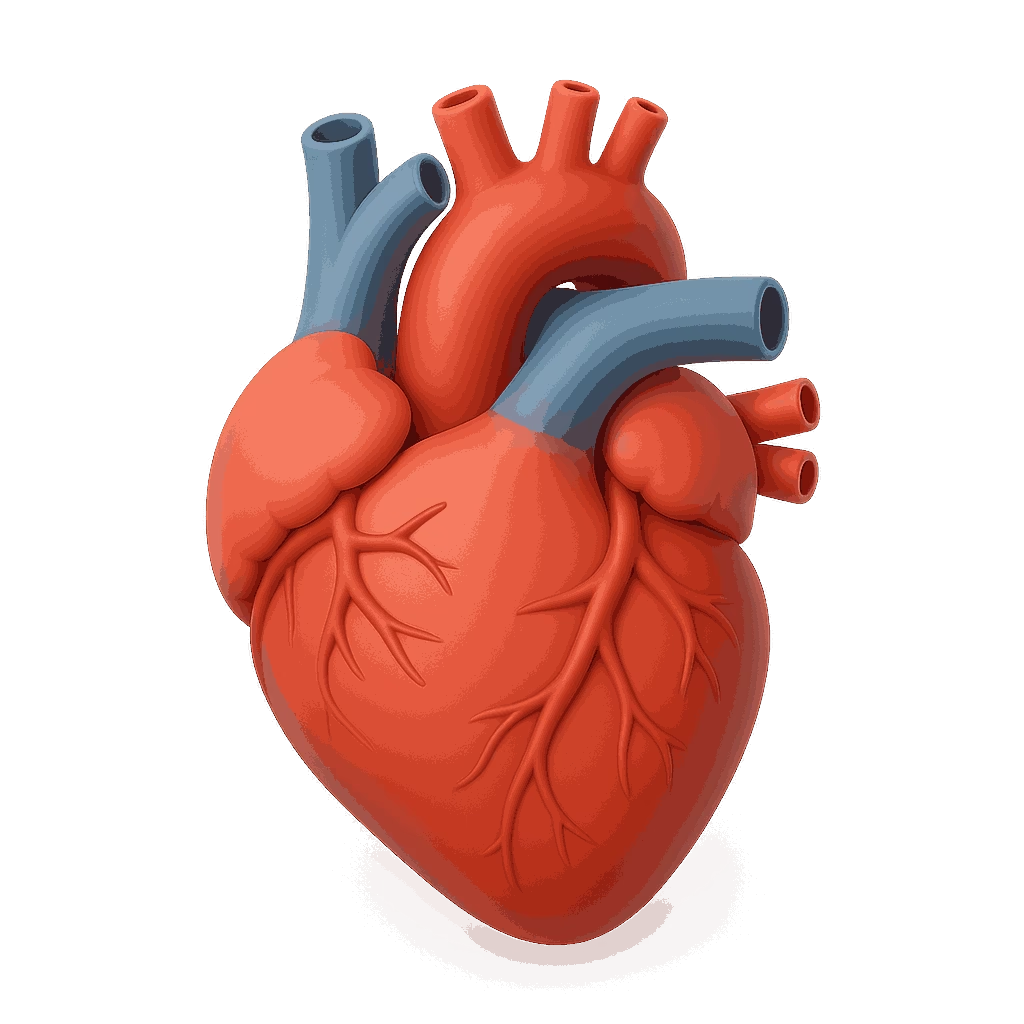
Our Pump: The Heart!
Your heart is a fist-sized muscle 💪 that works 24/7 to pump blood. It has **4 rooms (chambers)** to keep oxygen-rich and oxygen-poor blood separate – no mixing allowed!
Keyword Table
| Technical Word | Simple Meaning |
|---|---|
| Atria (singular: Atrium) | Upper heart chambers (entry rooms) 🚪 |
| Ventricles | Lower heart chambers (exit rooms) 🚀 |
| Valves | One-way doors → prevent blood backflow ⛔ |
Blood Flow: Step-by-Step!
Follow the blood’s journey through the heart:
Oxygen-Rich Blood Path (❤️):
- Lungs → Left Atrium (thin-walled entry room).
- Left Atrium squeezes → blood pushed into Left Ventricle (thick-walled exit room).
- Left Ventricle PUMPS! → blood sent to entire body.
Oxygen-Poor Blood Path (💙):
- Body → Right Atrium (entry room).
- Right Atrium squeezes → blood pushed into Right Ventricle.
- Right Ventricle PUMPS! → blood sent to lungs to grab oxygen.
⚡ Fun Fact: Your heart pumps blood 1 meter high – that’s like shooting water to your head! 💦
Why Thick Ventricles?
– Ventricles have thick muscles → need power to pump blood far!
– Left ventricle = strongest → pumps blood to your toes! 👣
– Atria walls = thin → only push blood to ventricles (short distance).
🩸 Fun Fact: Left ventricle pumps blood 5 km/day – Delhi to Gurgaon daily! 🚗
Valves: The Heart’s Doors!
– Tricuspid & Mitral valves → Between atria & ventricles.
– Pulmonary & Aortic valves → Between ventricles & arteries.
– “Lub-Dub” Sound:
- – *Lub* = Valves closing between atria/ventricles.
- – *Dub* = Valves closing to arteries.
⚠️ Key Detail: If valves leak → heart works harder!
Test Yourself!
Ans: Right Ventricle
Ans: Ventricles pump blood farther!
Quiz Time!
1. **Blood from the lungs enters the:**
2. **The “Dub” sound is made by:**
3. **Oxygen-poor blood goes to the lungs from the:**
Summary
- Heart = 4 Rooms:
- – Atria (top) → Entry rooms.
- – Ventricles (bottom) → Exit rooms (thick walls!).
- Blood Flow:
- – Lungs → Left Atrium → Left Ventricle → Body (❤️ oxygen-rich).
- – Body → Right Atrium → Right Ventricle → Lungs (💙 oxygen-poor).
- Valves → One-way doors → “Lub-Dub” sound.
- 🌟 Challenge:
- Place your hand on your heart ❤️. Feel the beat? That’s your left ventricle pumping oxygen-rich blood to your toes! 👣
Oxygen enters the blood in the lungs

Oxygen in Blood & Heart Secrets!
Imagine your blood is a delivery truck 🚚 – it picks up oxygen in the lungs and delivers it to your cells! Let’s see how your heart helps!
Keyword Table
| Technical Word | Simple Meaning |
|---|---|
| Alveoli | Balloon-like air sacs in lungs (O₂/CO₂ swap spot) 🎈 |
| Hemoglobin | Oxygen “taxi” in red blood cells 🔴 |
| Oxygenated Blood | Blood rich in oxygen (bright red) ❤️ |
| Deoxygenated Blood | Blood low in oxygen (dark red) 💙 |
| Double Circulation | Blood passes through heart *twice* per body trip 🔄 |
Step 1: Oxygen’s Entry!
1. You inhale → air reaches alveoli (millions of tiny balloons!).
2. Oxygen (O₂) crosses alveoli walls → enters blood.
3. Hemoglobin (in RBCs) grabs O₂ → becomes oxygenated blood (❤️ bright red!).
💨 Fun Fact: Each RBC carries 1 billion oxygen molecules!
Ans: **Alveoli**
Heart: The 4-Room Pump!
Your heart has 4 chambers to *separate* oxygen-rich and oxygen-poor blood:
- Right Side: Pumps deoxygenated blood (💙) → Lungs (to grab O₂).
- Left Side: Pumps oxygenated blood (❤️) → Body (to deliver O₂).
🚫 NO MIXING! → Super efficient for high-energy animals (humans, birds)!
🐦 Fun Fact: A hummingbird’s heart beats 1,200 times/minute while flying!
Ans: Prevents mixing → efficient oxygen supply!
Animal Heart Olympics!
| Animal Group | Heart Chambers | Blood Mixing? | Why? |
|---|---|---|---|
| Fish 🐟 | 2 | Yes | Blood goes: Heart → Gills → Body → Heart (1 loop) |
| Frogs/Snakes 🐍 | 3 | Some | Body temp = environment (less energy needed) |
| Birds/Humans 🦅 | 4 | No | Need energy to stay warm! |
⚠️ Key Concept:
– Double Circulation (4-chambered hearts): Blood passes through heart twice per body cycle (heart → lungs → heart → body).
– Single Circulation (fish): Blood passes through heart once (heart → gills → body).
🐟 Fun Fact: Fish hearts are like “pump stations” – weak pressure!
Quiz Time!
1. **Oxygen binds to ______ in blood.**
2. **Double circulation means blood flows through the heart:**
3. **Frogs have ______-chambered hearts.**
4. **Bright red blood shows it is:**
Summary
- Oxygen enters blood in alveoli (lungs) → carried by hemoglobin.
- 4-chambered heart separates blood:
- – *Right side:* 💙 → Lungs (grab O₂).
- – *Left side:* ❤️ → Body (deliver O₂).
- Double circulation = 2 heart trips/cycle (efficient for warm-blooded animals!).
- Fish (2 chambers) & Frogs (3 chambers) allow some blood mixing.
- 🌟 Challenge:
- Place your hand on your heart ❤️. Feel the beat? That’s your left ventricle pumping oxygen-rich blood to your toes! 👣
The tubes – blood vessels
Blood Vessels: The Body’s Plumbing System!
Imagine your blood vessels as roads 🛣️ – **arteries** are highways leaving the heart, **veins** are return lanes, and **capillaries** are tiny alleyways reaching every cell!
Keyword Table
| Technical Word | Simple Meaning |
|---|---|
| Arteries | Thick-walled tubes carrying blood *away* from heart ❤️→ |
| Veins | Thin-walled tubes with valves carrying blood *to* heart ←❤️ |
| Capillaries | Microscopic one-cell-thick vessels for material exchange 🔬 |
| Valves | One-way doors in veins → prevent backflow ⛔ |
Arteries: The High-Pressure Highways!
– Job: Carry oxygen-rich blood (except pulmonary artery) from heart → body.
– Walls: Thick + elastic → handle heart’s powerful pump 💥.
– Pressure: Blood spurts if cut! *(Don’t try this!)* 🚫
🌡️ Fun Fact: Your pulse (wrist/neck) is an artery expanding with each heartbeat! 💓
Ans: To handle high pressure from the heart!
Veins: The Return Lanes!
– Job: Bring oxygen-poor blood (except pulmonary vein) from body → heart.
– Walls: Thin → low pressure inside.
– Special Feature: Valves → stop blood from flowing backward (like one-way street signs! 🛑).
🦵 Fun Fact: Leg veins fight gravity – valves keep blood moving upward! ⬆️
Ans: Valves
Capillaries: The Delivery Alleys!
– Size: Microscopic → red blood cells squeeze through single-file!
– Walls: One-cell thick → easy exchange of:
- – O₂/food → out to cells 🍎
- – CO₂/waste → into blood 🗑️
🌟 Fun Fact: 10 capillaries = thickness of 1 human hair! 💇
Ans: Capillaries
Blood Flow Pathway:
Heart ❤️ → Artery (thick) → Arteriole (small artery) → Capillary (exchange) → Venule (small vein) → Vein (thin + valves) → Heart ❤️
⚠️ Key Detail:
– No cell is > 0.1 mm from a capillary – delivery service everywhere! 🚚
Quiz Time!
1. **Capillaries are:**
2. **Valves are present in:**
3. **Which vessel handles high pressure?**
4. **Material exchange happens in:**
Summary
- Vessel | Function | Special Feature
- Arteries | Carry blood FROM heart | Thick/elastic walls 💪
- Veins | Carry blood TO heart | Valves ⛔
- Capillaries | Exchange O₂/food for CO₂/waste | One-cell thick 🧱
- 🌟 Challenge:
- Make a fist ❤️ → Open/close it 70 times/minute. That’s your heart pumping blood through 100,000 km of vessels – enough to circle Earth twice! 🌍✨
Maintenance by platelets
Platelets: The Body’s Emergency Repair Crew!
Imagine your blood vessels are pipes. If they spring a leak (like a cut!), **platelets** are tiny heroes that rush to plug the hole and stop the bleeding! 🦸♂️
Keyword Table
| Technical Word | Simple Meaning |
|---|---|
| Platelets | Tiny cell fragments that form blood clots |
| Clot | A sticky plug sealing leaks (like a scab!) |
| Fibrin | Stringy protein net trapping blood cells 🕸️ |
How Platelets Save the Day!
1. Leak Alert! 🚑
You get a cut → blood vessel tears → platelets rush to the spot.
2. Sticky Patch! 🩸
Platelets clump together → form a temporary plug.
3. Net Trap! 🕸️
Platelets release chemicals → create fibrin (sticky net) → traps blood cells → forms a clot (scab).
🌟 Fun Fact: Platelets live only 7 days – your bone marrow makes 100 billion new ones daily! 💥
Ans: Clot (or scab)
Why Clotting Matters!
– Prevents Blood Loss: Without platelets, a tiny cut could make you lose all your blood! 😱
– Saves Pressure: Clots keep blood pressure stable → heart pumps efficiently ❤️.
– Blocks Germs: Scabs shield wounds from bacteria 🦠.
💡 Pro Tip: Eat spinach/vitamin K → helps platelets work better! 🥬
Quiz Time!
1. **Platelets help to:**
2. **Fibrin is a:**
3. **Clotting prevents:**
Summary
- Platelets = Tiny first-aid kits in your blood!
- Clotting Steps:
- Platelets rush → Stick together → Make fibrin net → Seal leak!
- Result: Stops bleeding + keeps blood pressure steady.
- 🌟 Challenge:
- Next time you get a small cut, watch the scab form – that’s platelets doing superhero work! 🦸♀️✨
- > 💉 Fun Fact: Mosquito bites itch because your platelets are *overreacting* to mosquito spit! 🦟
Lymph
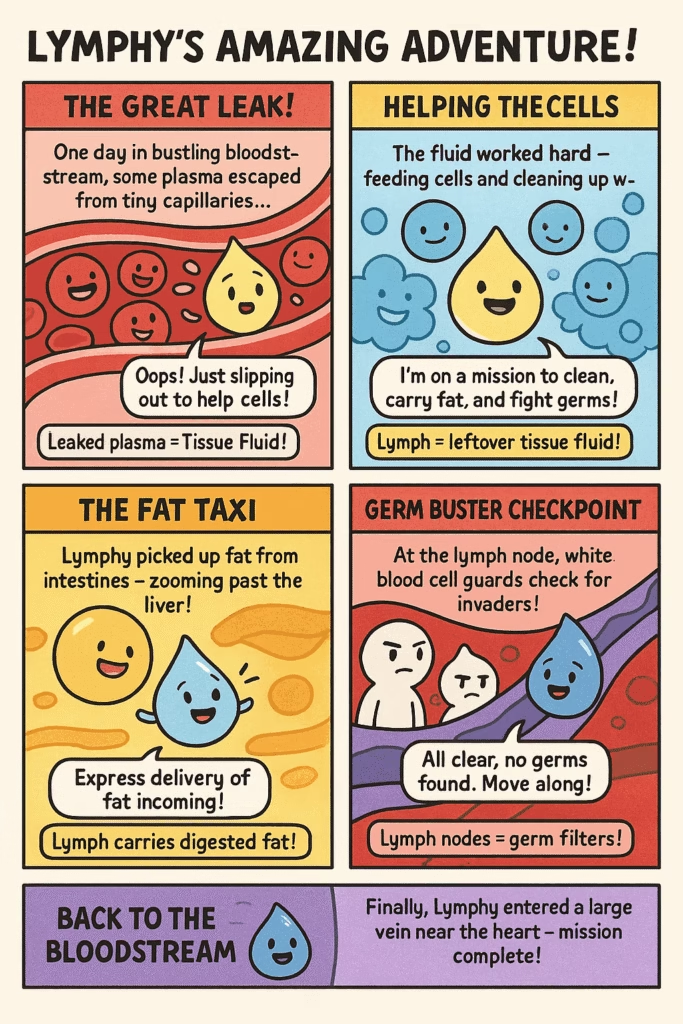
Lymph: The Body’s Cleanup Crew!
Imagine your body has a second “river system” 🌊 – called **lymph** – that cleans up spills and transports fat! It’s like the street sweeper of your body!
Keyword Table
| Technical Word | Simple Meaning |
|---|---|
| Lymph | Clear fluid that cleans tissues + carries fat |
| Tissue Fluid | Liquid leaking from blood into cell spaces |
| Lymphatic Capillaries | Tiny tubes collecting lymph 🧪 |
| Lymph Vessels | Large tubes draining lymph into veins |
How Lymph Forms:
1. Blood Leak! 🩸
At capillaries, plasma (blood liquid) leaks out → becomes tissue fluid around cells.
2. Cleanup Time! 🧹
This fluid:
- – Brings nutrients to cells.
- – Washes away waste/germs.
3. Lymph is Born! 💦
After cleaning, 90% of fluid returns to blood → 10% becomes lymph!
🌟 Fun Fact: You have twice as much lymph as blood in your body!
Ans: Plasma
Lymph’s Super Jobs!
1. Fat Taxi! 🍟
Carries digested fat from intestines → to blood (bypassing liver!).
2. Fluid Recycler! ♻️
Drains excess fluid from tissues → back to veins → prevents swelling!
3. Germ Fighter! 🦠
Contains white blood cells → attacks infections!
⚠️ Key Detail:
– Lymph flows one way: Tissues → Lymph vessels → Veins near heart ❤️.
🍔 Fun Fact: After a oily meal, lymph turns milky from fat!
Lymphatic System: The Drainage Network!
1. Lymphatic Capillaries:
– Tiny tubes → suck up lymph from tissues (like straws!).
2. Lymph Vessels:
– Merge into larger tubes → have valves (like veins!) → drain into chest veins.
3. Lymph Nodes:
– Checkpoints that filter germs → swell when you’re sick!
🦠 Fun Fact: Swollen “glands” in your neck? Those are lymph nodes fighting cold viruses! 🤒
Quiz Time!
1. **Lymph carries _____ from the intestines.**
2. **Lymphatic vessels drain into:**
3. **Swollen lymph nodes mean your body is:**
Summary
- Lymph = Clear fluid from leaked plasma.
- Functions:
- – Returns excess fluid to blood → no swelling!
- – Transports digested fat.
- – Helps fight germs.
- Pathway:
- Tissues → Lymph capillaries → Lymph vessels → Veins.
- 🌟 Challenge:
- After a scratch, watch for clear fluid oozing – that’s lymph at work! 🔍
Transportation in Plants
Transportation in Plants: The Silent Superhighway!
Plants don’t have hearts or blood, but they have **xylem and phloem** – nature’s plumbing system! They carry water, food, and minerals to every leaf, flower, and root. 🌸
Keyword Table
| Technical Word | Simple Meaning |
|---|---|
| Xylem | Dead tubes carrying water/minerals UP ↑ |
| Phloem | Living tubes carrying food DOWN ↓ 🍬 |
| Transpiration | Leaf “sweating” pulling water upward 💧 |
Why Do Plants Need Transport?
1. Roots suck water + minerals (nitrogen, phosphorus) from soil.
2. Leaves make food (sugar) via photosynthesis.
3. But roots ≠ leaves! Tall trees need a delivery system for:
- – Water → Up to leaves ☀️
- – Food → Down to roots/stems/fruits ⬇️
🌳 Fun Fact: The tallest tree (Redwood) is 115m tall – xylem carries water against gravity from roots to top! 🌲
Ans: Water and minerals
Xylem: The Water Elevator!
– Structure: Dead, hollow tubes (like straws!).
– Job: Carry water + minerals **upward** from roots → leaves.
– Driver: **Transpiration** – sunlight evaporates water from leaves → pulls water up like a chain! 🔗
💧 Key Detail: No pump needed – leaf “sweat” powers the flow!
🍃 Fun Fact: A single corn plant drinks 200 liters of water in its life! 🌽
Ans: Transpiration
Phloem: The Food Courier!
– Structure: Living tubes with sieve plates (like colanders!).
– Job: Carry sugary food (**sap**) **downward** from leaves → roots/fruits/storage.
– Driver: Pressure flow – leaves “push” sugar syrup to hungry parts. 🍯
🍓 Example: Mangoes get sweet because phloem delivers sugar from leaves! 🥭
⚠️ Key Detail: Phloem also sends food UP to growing buds and fruits!
Ans: Sap
Slow & Steady Wins the Race!
Plants don’t need fast transport because:
- – They don’t move → low energy needs.
- – Many cells are dead (like wood!) → don’t “eat”.
- – Transport is slow but steady – perfect for their lifestyle! 🐢
🍂 Fun Fact: Bamboo is the fastest transporter – grows 1 meter/day! 🎋
Quiz Time!
1. **Xylem carries:**
2. **Phloem tubes are made of:**
3. **Water loss from leaves is called:**
4. **Sugar moves from leaves to roots via:**
Summary
- Xylem:
- – Water/minerals ↑ (roots → leaves).
- – Powered by transpiration.
- Phloem:
- – Food (sap) ↓ (leaves → roots/fruits).
- – Powered by pressure flow.
- Plants need transport to bridge the root-leaf distance!
- 🌟 Challenge:
- Wrap a plastic bag around a leafy branch 🌿. Wait 1 hour → See droplets? That’s transpiration in action! 🔍
Transport of water In Plants
Transport of Water in Plants: Nature’s Super-Soaker System!
Plants drink water from roots → send it 100m high to leaves! No pump needed – just smart science! 🌿✨
Keyword Table
| Technical Word | Simple Meaning |
|---|---|
| Xylem | Dead straw-like tubes carrying water upward 🌊 |
| Tracheids | Thin xylem tubes in conifers (pine trees) |
| Root Pressure | Root cells pushing water up at night 🌙 |
| Transpiration | Leaf “sweating” pulling water ☀️ |
| Transpiration Pull | Suction force from leaves → like drinking with a straw 🥤 |
1. Xylem: The Water Pipes!
– Structure: Interconnected dead tubes (vessels + tracheids) → form a continuous pipeline from roots → leaves.
– Job: Carry water + minerals UP ↑ against gravity!
🌲 Fun Fact: In 115m tall redwoods, xylem acts like a 30-floor elevator! 🏢
Ans: Xylem
2. Root Pressure: Night Pump!
– How it works:
- Roots actively suck minerals from soil → minerals pile up inside root cells.
- Water rushes into roots (to balance mineral concentration).
- Creates root pressure → pushes water up xylem.
– When? Mainly at night when transpiration stops.
🌙 Key Detail: Root pressure = weak → can’t lift water in tall trees alone!
💧 Fun Fact: Cut a plant stem → sap oozes out – that’s root pressure in action!
3. Transpiration Pull: The Leaf Sucker!
– Step 1: Sun heats leaves → water evaporates from stomata (leaf pores).
– Step 2: Evaporation creates suction → pulls water from xylem.
– Step 3: Water molecules stick together like a chain → whole column rises! 🔗
🚀 Key Detail: This is the MAIN FORCE lifting water in tall trees during the day!
🍃 Fun Fact: A single oak tree “sweats” 150,000 liters/year – enough to fill a swimming pool! 🏊
Ans: Transpiration
4. Why Transpiration Rocks!
Besides moving water:
- 1. Cools Leaves: Like sweating cools you! ❄️
- 2. Delivers Minerals: Water = mineral taxi! 🚕
- 3. Keeps Plants Firm: Water pressure plumps up cells → no wilting! 💪
🌵 Desert Hack: Cacti open stomata only at night → save water!
Quiz Time!
1. **Transpiration happens through:**
2. **Water molecules stick together in xylem due to:**
3. **The main force lifting water in tall trees is:**
Summary
- 1. Xylem Tubes: Carry water/minerals upward.
- 2. Root Pressure: Pushes water at night (weak force).
- 3. Transpiration Pull:
- – Sun → evaporates water from leaves → creates suction.
- – Water chains climb like rope! 🧗
- 4. Bonus: Transpiration cools plants + delivers minerals.
- 🌟 Challenge:
- Place a leafy stem in colored water 💙 → Watch veins turn blue – that’s xylem transporting! 🔍
Transport of food and other substances In Plants
Transport of Food in Plants: The Sweet Delivery System!
Plants make food in their leaves 🌿 – but how do sugars reach roots, fruits, and flowers? Meet **phloem**, the living food highway that delivers snacks to every plant part! 🚚
Keyword Table
| Technical Word | Simple Meaning |
|---|---|
| Phloem | Living food tubes (sieve tubes + companion cells) |
| Translocation | Moving food/sap up or down the plant 🔄 |
| Sucrose | Sugar made in leaves 🍬 |
| Osmotic Pressure | Water rushing in to balance sugar levels 💧 |
Phloem: The Food Superhighway!
– Structure:
- – Sieve Tubes: Stacked cells with holes (like colanders!) → let sap flow.
- – Companion Cells: “Brainy helpers” that load/unload sugar using ATP energy! ⚡
– Job: Carry sugary sap (sucrose), amino acids, vitamins → to roots, fruits, buds.
🍓 Fun Fact: Strawberries get sweet because phloem pumps sugar from leaves!
Ans: Sucrose
Translocation: The Energy-Powered Delivery!
Step-by-Step Food Journey:
1. Loading:
– Leaves make sucrose → pumped into phloem by companion cells (uses ATP!).
2. Water Rush:
– High sugar in phloem → sucks in water (osmosis) → creates high pressure. 💧
3. Flow:
– Sap squirts from high-pressure areas (leaves) → low-pressure areas (hungry roots/buds).
4. Unloading:
– Sugar removed at destination → water leaves → pressure drops.
🌱 Example:
– Spring: Sugar stored in roots flows UP to new buds.
– Summer: Sugar from leaves flows DOWN to growing watermelons! 🍉
🔄 Key Detail: Phloem flows **both ways** – unlike xylem (only up!).
Ans: Osmotic pressure
Why Phloem Needs Energy
Unlike xylem (gravity/transpiration), phloem:
- – Uses ATP to load sugar → active transport.
- – Adjusts flow based on plant’s needs (e.g., more sugar to fruits in summer!).
🌰 Fun Fact: Maple syrup is boiled phloem sap from sugar maple trees! 🥞
Quiz Time!
1. **Companion cells help by:**
2. **Phloem transports:**
3. **Sap flows from ______ pressure to ______ pressure areas.**
Summary
- 1. Phloem = Food Tubes:
- – Sieve tubes (pipes) + Companion cells (helpers).
- 2. Translocation Process:
- – Sugar loaded → Water rushes in → High pressure → Sap flows.
- 3. Direction: Up or down to where food is needed (buds, roots, fruits).
- 🌟 Challenge:
- Taste a celery stem 🥬 – its sweetness comes from phloem sap!
- > 🌿 Science Rule:
- – Xylem: Water/minerals UP ↑ (passive).
- – Phloem: Food UP or DOWN 🔄 (active, needs ATP!).
EXCRETION
Excretion: The Body’s Cleanup Crew!
Imagine your body is a busy city 🏙️. Just like trash trucks remove garbage, **excretion** removes waste from your cells to keep you healthy!
Keyword Table
| Technical Word | Simple Meaning |
|---|---|
| Excretion | Removing harmful waste from the body 🗑️ |
| Metabolic Waste | Toxic leftovers from body activities ☠️ |
| Diffusion | Waste leaking out naturally (like perfume spreading) 💨 |
1. Tiny Organisms: Simple Cleanup!
Unicellular organisms (like amoeba):
- – Waste (ammonia, CO₂) diffuses out → through cell membrane → into water.
- – No special organs needed!
🌊 Fun Fact: A single-celled paramecium excretes waste in 2 seconds – faster than you blink! 👀
Ans: Simple diffusion
2. Big Organisms: Fancy Trash Systems!
Multicellular organisms (humans, animals, plants):
Need special organs because waste must travel far!
| Organ | Waste Removed | Example |
|---|---|---|
| Kidneys | Liquid waste (urine: urea, salts) 💧 | You pee 1-2 liters/day! |
| Lungs | Gaseous waste (CO₂) 🌬️ | You exhale CO₂! |
| Skin | Sweat (water, salts) 💦 | Stinky gym clothes! |
| Liver | Toxins (drugs, chemicals) 🧪 | Turns ammonia → urea |
🦁 Fun Fact: Birds and reptiles poop white paste (uric acid) to save water!
Ans: Lungs
3. Plant Excretion: Silent & Smart!
Plants remove waste differently:
- – Oxygen (from photosynthesis) → released through stomata! 🌿💨
- – Tannins, Resins → stored in leaves/bark → leaves fall to remove waste! 🍂
- – Gums → ooze out from stems (like mango tree sap!).
🌳 Fun Fact: Some plants use waste as weapons – walnut trees poison soil to kill competitors! ☠️
Quiz Time!
1. **Excretion removes:**
2. **Human skin excretes:**
3. **Plants release oxygen waste via:**
Summary
- 1. Excretion = Removing toxic waste (CO₂, urea, salts).
- 2. Unicellular organisms: Waste diffuses out.
- 3. Multicellular organisms: Use organs like kidneys, lungs, skin.
- 4. Plants: Release O₂, store waste in leaves, or ooze gums.
- 🌟 Challenge:
- Breathe on a mirror 👉 See fog? That’s CO₂ waste from excretion! 😮💨
- > 🔬 Science Rule: No living thing can survive without excretion – even plants sweat and breathe out waste!
Excretion in Human Beings

Excretory System in Humans: The Body’s Toilet System!
Imagine your blood is dirty dishwater 🍽️ – kidneys are the filters that clean it! Let’s tour this waste-removal factory!
Keyword Table
| Technical Word | Simple Meaning |
|---|---|
| Kidneys | Bean-shaped blood filters (make pee) 🌱 |
| Ureters | Tubes carrying pee to bladder |
| Urinary Bladder | Pee storage bag 🎈 |
| Urethra | Pee exit pipe 🚽 |
| Nephron | Tiny filter unit in kidney (1 million/kidney!) 🔍 |
| Bowman’s Capsule | Cup-shaped filter catcher 🥤 |
Kidneys: The Blood Cleaners!
– Job: Filter blood 300x/day → remove urea (toxic waste from protein), extra salts, water.
– Location: Back of your belly (size: your fist!).
🩸 Fun Fact: Kidneys clean all your blood every 5 minutes! ⏱️
Ans: Urea
Nephrons: The Mini Filters!
Each nephron works like a coffee filter:
1. Filtration:
– Blood enters capillary cluster → waste + water + good stuff (glucose) leak into Bowman’s capsule.
2. Re-absorption:
– Useful stuff (glucose, amino acids, 99% water) get sucked back into blood.
3. Urine Formation:
– Leftover liquid = pee (water + urea + salts).
🚰 Fun Fact: 180 liters of blood filtered daily → only 1-2 liters become pee!
Ans: Bowman’s capsule
Pee Pathway: From Filter to Toilet!
1. Kidneys → Make urine.
2. Ureters (2 thin tubes) → Carry urine to bladder.
3. Bladder → Stores urine (stretchy bag → holds 400-600 ml!).
4. Urethra → Pee exits when you “go”!
🧠 Brain Power:
- – Bladder nerves signal: “Time to pee!” 🚨
- – You can hold it (thanks to sphincter muscles!).
⚠️ Ouch! Holding too long → bladder pain!
Quiz Time!
1. **Urine is stored in the:**
2. **The tube carrying pee out is the:**
3. **Useful substances like glucose are:**
Summary
- 1. Kidneys = Blood filters → remove urea.
- 2. Nephrons = Filter units → make pee by:
- – Filtering blood.
- – Re-absorbing good stuff.
- 3. Pee Path:
- Kidneys → Ureters → Bladder → Urethra → OUT!
- 🌟 Fun Fact: Your pee is 95% water + 5% waste – drink water to keep kidneys happy! 💧
- > 💛 Health Tip: Pale yellow pee = healthy kidneys! Dark pee = drink more water!
Excretion in Plants
Excretion in Plants: Nature’s Silent Cleanup!
Plants don’t have kidneys or toilets, but they’re masters at waste management! 🌱✨ Here’s how they stay toxin-free without moving an inch!
Keyword Table
| Technical Word | Simple Meaning |
|---|---|
| Excretion | Removing harmful waste 🗑️ |
| Transpiration | “Sweating” out excess water 💧 |
| Resins & Gums | Sticky waste stored in bark/wood 🌲 |
| Vacuoles | Storage bubbles in cells holding waste 🫧 |
1. Oxygen: The “Good” Waste!
– During photosynthesis, plants make oxygen (O₂) as a by-product → released through stomata!
– Twist: This “waste” is what we breathe! 💨
🍃 Fun Fact: A tree makes enough oxygen daily for 4 people! 🌳❤️
Ans: Through stomata
2. Water Waste: Just Sweat It Out!
– Plants drink lots of water → excess removed via transpiration (leaf “sweat”).
– Bonus: Transpiration also cools leaves! ❄️
☀️ Fun Fact: A sunflower “sweats” 95% of its absorbed water! 🌻
3. Leaf Litter: Trash Bags That Fall!
– Toxic wastes (tannins, oxalates) stored in old leaves → leaves turn yellow/orange → drop off!
– Autumn leaf fall = plant detox! 🍁
⚠️ Key Detail: Plants sacrifice leaves to remove waste – like throwing out a garbage bag!
Ans: In cellular vacuoles
4. Resins & Gums: Sticky Storage!
– Resins: Yellowish waste in pine trees → used to make turpentine!
– Gums: Gooey blobs on mango/cherry trunks → used in jellies and glue!
🍯 Fun Fact: Chewing gum was originally made from tree resin!
5. Soil Secretions: Root Detox!
– Roots release wastes (salts, acids) into soil → absorbed by soil microbes.
– Example: Mustard plants release toxins to kill competing weeds! ☠️
Quiz Time!
1. **Transpiration removes:**
2. **Vacuoles in plant cells store:**
3. **Pine trees store waste as:**
Summary
- Plants excrete waste by:
- 1. Releasing O₂ via stomata (photosynthesis waste).
- 2. “Sweating” water via transpiration.
- 3. Storing toxins in vacuoles/old leaves → leaf drop!
- 4. Oozing resins/gums from bark.
- 5. Secreting waste into soil through roots.
- 🌟 Fun Fact: Ancient amber jewelry is fossilized tree resin – 100-million-year-old plant waste! 💎
- > 🌍 Eco-Tip: Fallen leaves recycle waste into soil nutrients – don’t trash them, compost! ♻️
Conclusion : Explanation-Life Processes Class 10
From photosynthesis to human excretion, this Explanation-Life Processes Class 10 guide makes NCERT concepts stick! Recap key terms, test yourself with quizzes, and remember: life processes are nature’s genius – keeping organisms alive, growing, and thriving! Ready to top your exams?
Now,
You must practice MCQs related to this chapter. Click Here to practice the MCQs

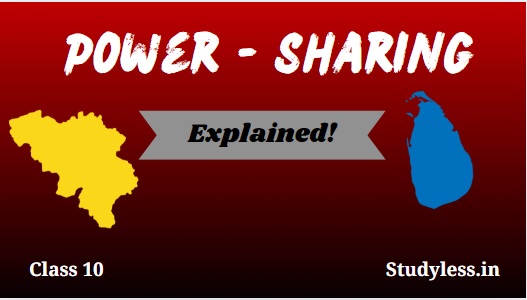
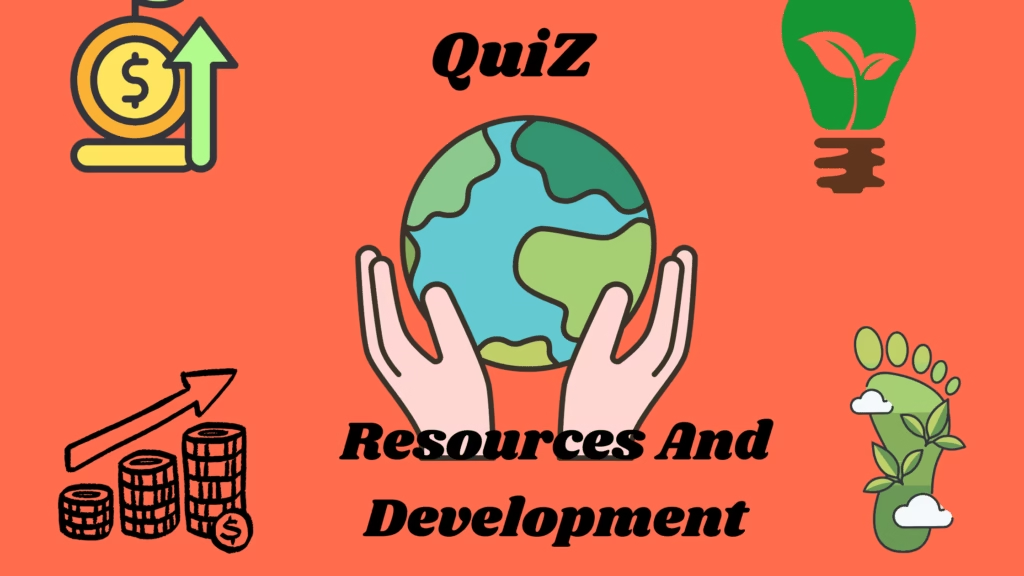
![[2025] Federalism Explained! : Brilliant & Game-Changer – Master India’s Power-Sharing Secrets for Class 10](https://studyless.in/wp-content/uploads/2025/04/100-MCQs-ON_11zon-1024x576.avif)

Leave a Comment